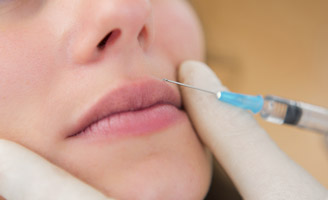Cosmetic injections
- After having a cosmetic injection it is common to experience local pain, tenderness and bruising.
- The botulinum toxin can cause serious side events if it spreads past the muscle into which it has been injected.
- Only a medical practitioner or a nurse practitioner may prescribe cosmetic injections.
Cosmetic injections are injectable substances used to reduce facial wrinkles and lines.
Cosmetic injections include:

- dermal fillers
- Botulinum toxin type A injections.
Dermal fillers include:
- collagen (Zyderm, Zyplast)
- hyaluronic acid (Restylane, Perlane, Juvéderm)
- polylactic acid (Sculptra)
Botulinum toxin type A, commonly known as the trade names Botox® and Dysport®, is a medicine which comes from the bacterium Clostridium botulinum.
The botulinum toxin blocks the release of a neurotransmitter at a nerve terminal (or nerve ending), which results in localised muscle weakness or paralysis.
How cosmetic injections are used
Dermal fillers are piped by injection to ‘fill’ the wrinkle, line or skin depression producing a wrinkle smoothing effect.
Botulinum toxin can be used in cosmetic procedures, despite the fact that one of the most serious complications of the toxin is paralysis. In cosmetic procedures, small, diluted amounts are directly injected into specific muscles causing controlled weakening of the muscles and smoothing wrinkles and facial creases.
Botulinum toxin is now commonly used to smooth frown, crow's feet (lines around the eye) and forehead lines. Wrinkles caused by sun damage and gravity will not respond to botulinum toxin.
The cosmetic effects of most cosmetic injections are temporary.
The dangers of cosmetic injections
The fact that the above cosmetic injections are a prescription only medicine shows there is an element of danger associated with its use.
Safe use of these products requires proper medical oversight due to:
- risks from the medication itself
- risks from administration (injection)
- complexity of the conditions being treated.
Side effects of using botulinum toxin
After having a cosmetic injection it is common to experience local pain, tenderness, and bruising. With any injection, there is a low risk of infection or allergic reaction.
The botulinum toxin can cause serious side effects if it spreads past the muscle into which it has been injected. These side effects can include drooping eyelid, double vision, difficulty swallowing and speaking, general weakness and respiratory failure.
In rare instances deaths have occurred in patients who have used botulinum toxin and who have other significant illnesses.
Using cosmetic injections
Treatment with cosmetic injections cannot be started without first having a consultation with an authorised medical practitioner or nurse practitioner.
Only after this is it legal for a Registered Nurse to administer a prescription medicine under the direction of that practitioner. If a consultation is not carried out, it is illegal for anyone to independently purchase, obtain, administer or supply prescription medicines.
To determine if a medical practitioner, nurse practitioner, or nurse is registered, a check can be made on the Australian Health Practitioner Regulation Agency (AHPRA) website (external site).
Prior to receiving cosmetic injections it is strongly recommended that these checks be made to ensure the validity of both the authorising doctor and administering nurse.
If any business or person refuses to supply you with the information required to check the registration, it is strongly recommended that treatment is declined and that the matter is reported to the
Medicines and Poisons Regulation Branch (external site).
Safety checklist
- Ensure your practitioner is a qualified doctor or nurse. This can be checked on the AHPRA register (external site).
- Ensure the cosmetic injection to be used is registered with the Therapeutic Good Administration. All registered medicines must display an 'AUST R' number (external site) on the label as proof of registration.
- Ensure practitioners use the necessary aseptic techniques (external site) to avoid contamination of sterile injection equipment.
- Talk to the provider about his/her safe injection practice (external site). For example, healthcare providers should not use the same syringe on more than one patient, even if the needle is changed.
- Injection bottles that are labelled as single-dose or single-use should be used for a single patient and single case/procedure/injection.
Where to get help
Acknowledgements
Pharmaceutical Services Branch
This publication is provided for education and information purposes only. It is not a substitute for professional medical care. Information about a therapy, service, product or treatment does not imply endorsement and is not intended to replace advice from your healthcare professional. Readers should note that over time currency and completeness of the information may change. All users should seek advice from a qualified healthcare professional for a diagnosis and answers to their medical questions.